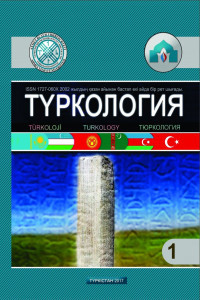ALGISAL ETİMOLOJİ VE YENİ DÜŞÜNCELERLE ESKİ TÜRKÇE ‘IMGA’ İLE ‘İL IMGA’NIN KÖKENİ
Eski Türkçe, Çince, Hotanca, idari-askerî unvanlar, algısal etimoloji, Old Turkic, Chinese, Khotanese, administrative-military titles, perceptual etymology, древнетюркские, китайские, хотанские, военно-административные титулы, перцептивная этимология, Көне түркі, қытай, хотан, әкімшілік-әскери титулдар, перцептивті этимология
The Perceptual Etymology and the Origin of the Old Turkic ‘Ïmga’ and ‘Il Ïmga’ via the New Thoughts
Old Turkic, Chinese, Khotanese, administrative-military titles, perceptual etymology, древнетюркские, китайские, хотанские, военно-административные титулы, перцептивная этимология, Көне түркі, қытай, хотан, әкімшілік-әскери титулдар, перцептивті этимология,
___
- Stachowski, M. (2022). Perceptual etymology. A social aspect of etymological research. Studia Linguistica Universitatis Iagellonicae Cracoviensis,139 (1): 61-67.
- Stachowski, M. (2021). Perceptual etymology, or three Turkish culinary terms in Croatian and Slovene, and a Polish social term inteligencja ‘intelligentsia’. Studia Linguistica Universitatis Iagellonicae Cracoviensis,138 (4): 221-225.
- Liberman, A. (2005). Word origins… and how we know them. Oxford: Oxford University Press. Stachowski, K. (2017). An experiment in labelling Draw-a-Map maps. Studies in Polish Linguistics 12 (4): 221–240.
- Stachowski, K. (2018). Przyczynek do dialektologii percepcyjnej Polski: Szczecin. Język Polski 98 (1): 5–17.
- Donuk, A. (1988). Eski Türk devletlerinde idarî-askerî unvan ve terimler. İstanbul: TDAV.
- Kilisli Rifat [Bilge] (Haz.) (1333-1335). Kâşgarlı Mahmud, Kitâb-ı Dîvânu Lugâti’t-Türk, I-III. İstanbul.
- Dankoff, R. ve Kelly, J. (1982). Maḥmūd el-Kāšγarī, Compendium of the Turkic Dialects (Dīwān Luγāt at-Turk), Part I, Sources of Oriental Languages and Literatures, Turkish Sources:7. Harvard University.
- Ercilasun, A. B. ve Z. Akkoyunlu. (Haz.) (2015). Kâşgarlı Mahmud Dîvânu Lugâti’t-Türk, giriş-metin-çeviri-notlar-dizin (2. bs.). Ankara: Türk Dil Kurumu Yayınları.
- Arat, R. R. (1947). Kutadgu Bilig, I Metin. İstanbul: Millî Eğitim Basımevi.
- Kaçalin, M. S. (Haz.) (2008).Yûsuf Has Hâcib: Kutadğu Bilig, Metin. Kültür ve Turizm Bak. Yayınları (e-kitap).https://ekitap.ktb.gov.tr/TR-78447/yusuf-has-hacib---kutadgu-bilig.html (Erişim tarihi: 09.06.2022).
- Arat, R. R. (1959). Kutadgu Bilig, II Tercüme. Ankara: TTK Basımevi.
- Clauson, Sir G. (1972). An Etymological Dictionary of Pre-Thirteenth-Century Turkish. Oxford: Clarendon Press.
- Sims-Williams, N. ve Hamilton, J. (1990). Documents turco-sogdiens du IXe -Xe siècle de Touen-houang. London: School of Oriental and African Studies.
- Takata, T. (1987). Ąmäga. Studies in the vocabulary of Khotanese II. (R. E. Emmerick ve P. O. Skjærvø). Wien: Der Österreichischen Akademie der Wissenschaften, 17-18.
- Mathews, R. H. (1972). Chinese-English Dictionary. Revised American Edition. (Twelfth Printing). Cambridge/Massachusetts: Harvard University Press.
- Skaff, J. K. (2012). Sui-Tang China and its Turko-Mongol neighbors. Culture, power, and connections, 580-800. New York: Oxford University Press.
- Ouyang, X. (2004). Historical records of the five dynasties. (Çev.) R. L. Davis. New York: Columbia University Press.
- Wilkens, J. (2021). Handwörterbuch des Altuigurischen Altuigurisch – Deutsch – Türkisch. Göttingen: Universitätsverlag Göttingen.
- Moriyasu, T. (2019). Corpus of the Old Uighur letters from the Eastern Silk Road. Berliner Turfantexte XLVI. Turnhout: Brepols Publishers.
- Arslan, H. Ç. (2021). Eski Uygur mektuplarının incelenmesi ve söz varlığının Hakasça ile karşılaştırılması. Çukurova Üniversitesi Sosyal Bilimler Enstitüsü. Yayımlanmamış Doktora Tezi. Adana.
- Turfanforschung Digitales Turfan-Archiv (2022). [2005]. Berlin-Brandenburgischen Akademie der Wissenschaften in der Staatsbibliothek zu Berlin-Preussischer Kulturbesitz Orientabteilung. Berlin: http://turfan.bbaw.de/dta/u/dta_u_ index.htm. (Erişim tarihi: 11.06.2022).
- Clauson, Sir G. (1973). Turkish philology in Hungary. = Review of L. Ligeti (ed.), Studia Turcica, Budapest 1971. Asia Major, NS. 18, 209-219.
- Clark, L. V. (1977). Mongol elements in Old Turkic? Journal de la Société Finno-Ougrienne 75: 110-168.
- Moriyasu, T. (1991). ウイグル=マニ教史の研究 Uiguru Manikyō-shi no kenkyū [A Study on the History of Uighur Manichaeism]. Ōsaka daigaku bungakubu kiyō [Memoirs of the Faculty of Letters Osaka University] 31/32.
- Moriyasu, T. (2004). Die Geschichte des uigurischen Manichäismus an der Seidenstrasse: Forschungen zu manichäischen Quellen und ihrem geschichtlichen Hintergrund. Band 50 der Studies in Oriental religions. Wiesbaden: Otto Harrassowitz Verlag.
- Hamilton, J. R. (2004). Remarks concerning Turfan stake inscription III. In Turfan Revisited - The first century of research into the arts and cultures of the Silk Road. (Eds.) D. Durkin-Meisterernst et al. Berlin: Dietrich Reimer Verlag, 121–124.
- Moriyasu, T. (2015). Tōzai Uiguru to Cyūō Yūrasia 東西ウイグルと中央ユ ーラシア [East- and West-Uighurs in the Central Eurasia]. Nagoya: The University of Nagoya Press.
- Aydın, E. (2009). Köl Tigin ve Bilge Kağan Yazıtlarındaki Amga (Amgı) Korgan Üzerine. Turkish Studies, Vol. 4/3 (Spring): 273-282.
- Malov, S. Ye. (1951). Pamyatniki Drevnetyurkskoy Pis’mennosti. Moskva-Leningrad: İzdatel’stvo Akademiya NAUK SSSR.
- Nadelyayev, V. M., vd. (1969). Drevnetyurkskiy slovar’. Leningrad: Akademiya Nauk SSSR.
- ISSN: 1727-060X
- Başlangıç: 2002
- Yayıncı: Hoca Ahmet Yesevi Uluslararası Türk-Kazak Üniversitesi
KIRGIZ TÜRKÇESİNİN DİYALEKTOLOJİSİ ÜZERİNE BİR İNCELEME
Klasik Edebiyatın ve Halk Edebiyatının Etkileşimi Bağlamında Nazireler
ALGISAL ETİMOLOJİ VE YENİ DÜŞÜNCELERLE ESKİ TÜRKÇE ‘IMGA’ İLE ‘İL IMGA’NIN KÖKENİ
MOHAÇ MUHAREBESİ ARİFESİNDE OSMANLILARA KARŞI AVRUPA’DA KOALİSYON ARAYIŞLARI VE MACARİSTAN
ARAP HARFLİ ÇOK DİLLİ SÖZLÜKLERDE MOĞOLCA ASKERÎ TERMİNOLOJİ
ESKİ TÜRKÇEDE “ÇOKLUK, FAZLALIK, AŞIRILIK” BİLDİREN MİKTAR NİTELEYİCİLERİNİN TİPOLOJİSİ
Kenan AZILI, Ahmet AKPINAR, Figen PATIHAN
MACAR BELGELERİNDE TÁLTOS MÜCADELELERİ
